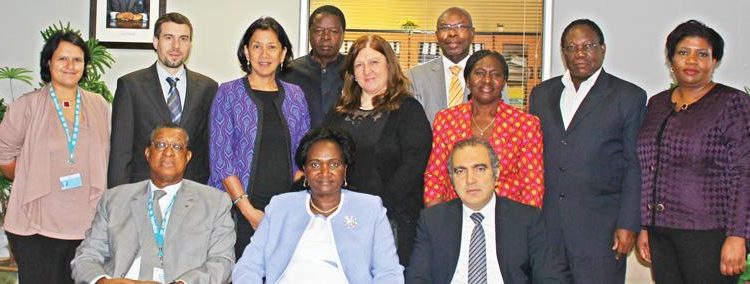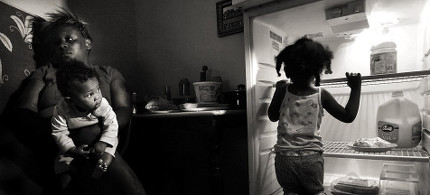América del Norte/EEUU/Abril 2016/Autor: Gillian B. White/ Fuente: The Atlantic
Resumen: En los Estados Unidos de América a pesar de que todos los grupos pueden sufrir de inseguridad financiera; sin embargo para los negros y los hispanos en ese país las consecuencias pueden ser mucho peor. Concretamente en lo referente a las diferencias en las estructuras educativas y familiares que representan algunas de las diferenciaciones de los salarios.
Stories like the one told in this month’s cover story—of a well-off white professional whose finances are a wreck—seem to suggest that financial calamity can strike anyone, of any race or income level, via a series of unfortunate events or financial missteps. “Financial impotence is an equal-opportunity malady, striking across every demographic divide,” writes Neal Gabler, the story’s author.
It might be true that this can happen to anyone, but for minorities, it’s far, far more likely. It’s also true that in the event of a downturn—personal or market-wide—they fall harder, faster. They have fewer resources for digging themselves out of a hole, and they are unlikely to know anyone who is much better off who could spot them the needed cash. Financial insecurity is in no way an equal-opportunity offender.
When it comes to measuring this problem, the ability to dig into one’s emergency fund to cover it is a popular heuristic. According to Pew, common emergency expenses—such as a car repair, hospital bill, or a sudden job loss—can eat up as much as $2,000. Most American households—regardless of income —don’t have that much set aside to cover such shocks. Many white families could instead turn to liquid assets, such as stocks or bonds or other savings to bridge the gap. But that’s just not possible for the majority of minorities. “Households of color are particularly fragile: A quarter of black households would have less than $5 if they liquidated all of their financial assets,” the study’s author Erin Currier, the director of financial security and mobility project at Pew Charitable Trust writes.
Such numbers are distressing but not surprising: Blacks and Hispanics continue to struggle economically. In 2013, the median white family had wealth that totaled more than $140,000, Hispanics had only $14,000. And black Americans had $11,000. People of color are less likely to belong to the seemingly safe middle class —about 45 percent and 48 percent respectively. For whites, more than half of the population, around 52 percent, is middle class. Those numbers might not seem all that far apart, but when you take a look at the median incomes within racial groups (for a family of three) the disparities become clearer: Based on 2012 data, children of white families that fall into the middle quintile of earners made around $55,000 each year. Black children whose families were also middle quintile wind up earning around $13,000 less. The median income of whites was higher than that of blacks for at each quintile. That means that even when they fall into the same economic class, these groups are still pretty far apart in terms of actual earnings, says Richard Fry, a senior researcher at the Pew Research Center.
And once in the middle class, it’s harder for black Americans to stay there. (Most mobility data is restricted to comparisons between blacks and whites and does not include Hispanics or Asian Americans.) “When comparing intergenerational economic mobility by race, the data show that more than half of African Americans raised in the middle quintile fall out of the middle as adults, compared to about a third of whites,” Currier said. “Unfortunately, there were so few black parents in the top two income quintiles that examining the economic mobility of their children is not possible,” she added.
What is driving these disparities? Part of the problem is that the ways that families accumulate wealth are stacked against blacks and Hispanics. Housing—equity in which makes up more than 60 percent of the average American household’s wealth—is a major factor. Even decades after the formal cessation of redlining, blacks and Hispanics are significantly less likely to be homeowners than their white counterparts. At the start of 2016, the homeownership for white Americans was 72 percent. For Hispanics it was 47 percent. For blacks it was 41 percent. Even for those minorities who are able to buy homes, the benefits are more muted than they are for white Americans. Why? Blacks and Hispanics are more likely to live in low-income neighborhoods, which means that their homes don’t appreciate as much as they would if they were somewhere else. But more than that, when these families do move to mostly white neighborhoods, they nevertheless tend to also suffer. In fact, studies have shown that once more than 10 percent of a neighborhood becomes populated by black households, property values begin to decline simply because of their presence.
A prime example of this inequality is the aftermath of the housing crisis. While whites are more likely to own homes, they are also more likely to own other assets. For black homeowners, however, houses account for just about all of their wealth. That means that the recession gutted nearly all of the black wealth that there was. A report from the ACLU estimates that by 2031, white families’ wealth will be about 31 percent lower because of the recession. Black families will have given up around 40 percent of their wealth.
Taxes can play a role too. According to Dorothy Brown, a professor of tax law at Emory University, some of the credits, deductions, and rules that provide windfalls for families at tax time give white families more of a boost than black or Hispanic ones. “Tax law is a political, a social, and an economic document. So of course there are going to be racial disparities.” Brown says. “To say, ‘the tax law is neutral’ is just nonsense.”
The mortgage interest deduction, for instance, which allows filers to reduce their taxable income, accounted for nearly $70 billion worth of deductions in 2013, and disproportionately helps white households, who make up the bulk of homeowners. And one credit that many assume largely helps minorities—the Earned Income Tax Credit—goes half to white people, Brown says. There are other culprits too, like the way joint returns reward or penalize couples based on earnings. “When blacks marry, they actually have their taxes go up, when whites marry, their taxes go down,” Brown says. Why is this? When couples marry and file a joint return, they can receive either a marriage bonus, which could be as high as 20 percent of their income, or be charged a marriage penalty, which could cost them as much as 12 percent, according to the Tax Foundation. The deciding factor is how close the two individuals’ incomes are: The bigger the gap the bigger the bonus. Brown says that this winds up penalizing black joint filers at a disproportionately high rate, since married black couples are more likely to have similar incomes, while households where one spouse works and the other stays home—the households that receive the biggest bonus—tend to be white. And the same goes for tax-advantaged savings accounts, like pensions and other retirement plans, which Brown says whites are more likely to have access to and to make use of, giving them a huge boost when it comes to building tax-free wealth for later in life.
In Gabler’s piece for instance, he notes that his financial predicament left him unable to pay for his children’s college education. So he turned to his own parents, who were able to provide the money for elite educations (at the cost of his own inheritance). It’s pretty unlikely than blacks or Hispanics would have access to these financial resources at all, from parents or grandparents. What’s more, windfalls like an inheritance come with tax advantages that a bonus from work or sudden jump in income don’t. It’s not just that white Americans tend to earn more, it’s that they hold more wealth: Less debt, more home equity, more stocks and bonds, more flush retirement accounts. These economic advantages accrue over time and then get passed down to the next generation, who in turn, are able to start their adult lives with a financial cushion, which can help them weather schools debt, unemployment, high rental prices, down payments, and emergencies of all varieties without doing the financially ruinous things that their peers without that backing may have to do. The lucky few who are able to do this, are, by and large, white.
The idea that parents or grandparents can swoop in to help their children buy a home, pay off a credit card, or cover the cost of college is mostly a reality for white America. That might be part of the reason that black young adults are more likely to owe on student loans (44 percent) compared to white young adults (35 percent). And sadly, a lot of the debt owed by young black and Hispanic adults is for degrees that they didn’t manage to complete, Currier says. These educational rifts, along with differences in family income and structure certainly play a part in the cyclical financial problems of minorities. But there’s more to it.
The persistent lag in wealth have been attributed to some of the same inconsistencies that account for income gaps, but they don’t explain the entire, vast discord. A 2015 report from the St. Louis Fed states, “Other factors must be in play, including early childhood experiences, parental influences and, of course, deep and historical discrimination against blacks and other minorities.”
Fry says that differences in education and family structures account for some of the differentiation in wages, but certainly not all of it. “Even when you look for equally well-educated blacks and whites there’s still a significant gap, which may point to overt discrimination,” he says. And that is especially troubling since income is the starting point for financial security in the first place. Most households get their money from working and wages—areas where minorities are historically and persistently disadvantaged.
That helps explain why blacks and Hispanics have such a hard time building wealth. “When you have low income you spend most of your money. You use it on your basic expenses, there isn’t much to save,” Fry says.
These discrepancies, in wealth and income, don’t just matter for a household’s current financial success, they set a path for what will happen for a family’s children, and grandchildren, and whether or not, over time, a family will be able to increase, or at least maintain their economic standing. But that, too, is deeply colored by race.
Fuente de la noticia: http://readersupportednews.org/news-section2/318-66/36464-not-all-money-troubles-are-equal-why-blacks-and-hispanics-have-it-much-worse
Fuente de la imagen: http://readersupportednews.org/images/stories/article_imgs20/020753-poverty-042216.jpg














 Users Today : 3
Users Today : 3 Total Users : 35420983
Total Users : 35420983 Views Today : 3
Views Today : 3 Total views : 3355685
Total views : 3355685